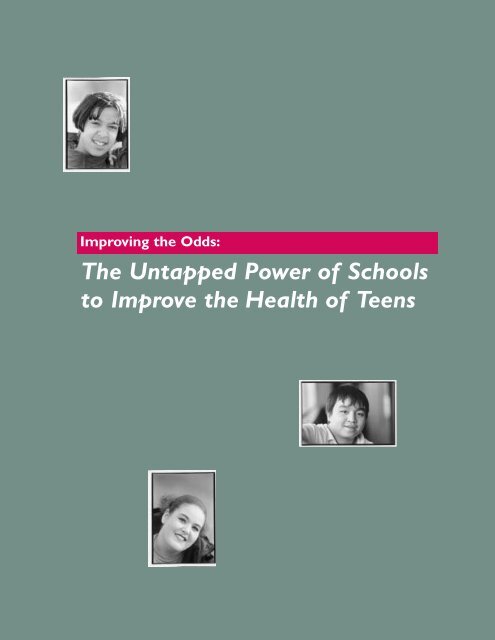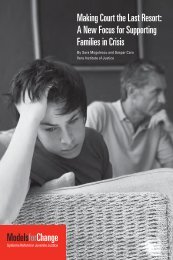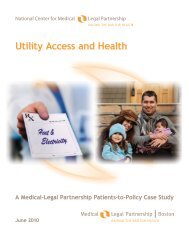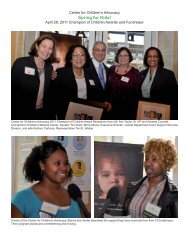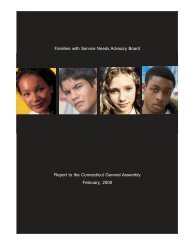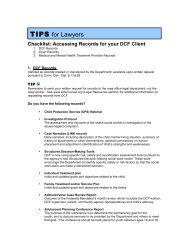The Untapped Power of Schools to Improve the Health of Teens
The Untapped Power of Schools to Improve the Health of Teens
The Untapped Power of Schools to Improve the Health of Teens
- No tags were found...
Create successful ePaper yourself
Turn your PDF publications into a flip-book with our unique Google optimized e-Paper software.
Measuring School Connectedness*School connectedness was measured based on responses t<strong>of</strong>ive questions:“How strongly do you agree or disagree with each <strong>of</strong><strong>the</strong> following statements:■ I feel close <strong>to</strong> people at this school.■ I am happy <strong>to</strong> be at this school.■ I feel like I am part <strong>of</strong> this school.■ <strong>The</strong> teachers at this school treat students fairly?■ I feel safe in my school.”Students resonded on a 5-point scale from “strongly agree.”*<strong>The</strong> first three questions were used for <strong>the</strong> Moody and Bearman analysis <strong>of</strong> friendshipgroups. This scale is called “school attachment.” All five questions were used for <strong>the</strong>McNeely, Nonnemaker and Blum analysis. This scale is called “school connectedness.”A PROFILE OF AMERICANMIDDLE AND HIGH SCHOOLS<strong>The</strong> Add <strong>Health</strong> Study includes samples<strong>of</strong> just about every type <strong>of</strong> middleschool and high school across <strong>the</strong> country.Taken <strong>to</strong>ge<strong>the</strong>r, <strong>the</strong> schools in Add <strong>Health</strong>are representative <strong>of</strong> all schools in <strong>the</strong>United States, including public, private andparochial schools.Add health data show that:■ Most schools (83%) are public schools.■ <strong>The</strong> average school size is around 650students; however, <strong>the</strong>re is a big range insize, from 25 students <strong>to</strong> over 5,000.■ <strong>The</strong> average class size is just under 23students, with a range from 10 <strong>to</strong> 39students in a class.■ More than two-fifths (42%) <strong>of</strong> teachershave <strong>the</strong>ir Master’s degree.■ <strong>The</strong> average school has about one ineleven teachers who are in <strong>the</strong>ir firstyear <strong>of</strong> teaching at <strong>the</strong> school.■■■Most students (83%) participate in atleast one extracurricular school activity– ei<strong>the</strong>r during <strong>the</strong> school day or afterschool – but <strong>the</strong> range is huge, from100% participation <strong>to</strong> 41%.Nearly 38% <strong>of</strong> schools give out-<strong>of</strong>schoolsuspension <strong>the</strong> first time astudent is caught smoking.Four percent <strong>of</strong> schools give out-<strong>of</strong>schoolsuspension <strong>the</strong> first time astudent is caught cheating.9
Well-managed classrooms are mostlikely <strong>to</strong> exist when:■ <strong>The</strong> school sets clear expectationsfor individual responsibilityand conflict resolution amongstudents;■ Teachers consistentlyacknowledge all students;■ Students participate in <strong>the</strong>management <strong>of</strong> <strong>the</strong> classroom— <strong>the</strong>y do regular jobs, haveinput on classroom rules andhelp set grading criteria.School CompositionStudents feel more connected <strong>to</strong>school when friendship groups areracially integrated. However, <strong>the</strong>researchers found that when a school isracially integrated, friendship groupswithin a school tend <strong>to</strong> be raciallysegregated.Apparently, students prefer <strong>to</strong> formfriendships with young people <strong>of</strong> <strong>the</strong>irown race. When <strong>the</strong>re are enoughstudents <strong>of</strong> each racial group <strong>to</strong> formfriendships with peers <strong>of</strong> one’s own race,racial groups tend <strong>to</strong> isolate <strong>the</strong>mselvesfrom one ano<strong>the</strong>r along racial boundaries.When this occurs, overall connectednessdeclines (see sidebar Mapping FriendshipGroups).This finding was not true for allschools. <strong>The</strong>re were a few schools withlarge numbers <strong>of</strong> both African Americanand White students and integrated friendshipgroups. But <strong>the</strong>se were <strong>the</strong> exception.Clearly, <strong>the</strong>re is a need <strong>to</strong> go beyondour current integration practices, whichfocus on numeric integration <strong>of</strong> <strong>the</strong>school as a whole and neglect integrationwithin a school. For example, <strong>to</strong> <strong>the</strong>extent that minority students aredisproportionately assigned <strong>to</strong> lowertrackclasses, school policies can unintentionallyexacerbate <strong>the</strong> segregation<strong>of</strong> friendship groups.10
School SizeStudents in smaller schools feel moreconnected <strong>to</strong> school, on average, thanstudents in larger schools. This findingcontributes <strong>to</strong> <strong>the</strong> mounting evidencethat very large schools are not good forengaging kids in school.<strong>The</strong> effect <strong>of</strong> school size onconnectedness is not <strong>the</strong> same as <strong>the</strong>effect <strong>of</strong> school size on academicachievement. <strong>The</strong> optimal school size forincreasing school connectedness is under600 students. In small schools, teachersand school leaders can personallyconnect with most students, animpossible feat in a large school.On <strong>the</strong> o<strong>the</strong>r hand, studies onlearning report that <strong>the</strong> optimal highschool size for high academic achievementis between 600 and 1,200 students.<strong>Schools</strong> <strong>of</strong> this size have <strong>the</strong> capacity <strong>to</strong><strong>of</strong>fer a wide variety <strong>of</strong> courses andcurricula. None<strong>the</strong>less, <strong>the</strong> findingssupport <strong>the</strong> growing evidence that verylarge schools, those over 1,200, are notgood environments for adolescents ei<strong>the</strong>reducationally or socially.Percent <strong>of</strong> students who are Latino.Percent <strong>of</strong> students from two-parent families.Teacher QualificationsPercent <strong>of</strong> teachers in <strong>the</strong>ir first year <strong>of</strong> teaching at <strong>the</strong> school.Percent <strong>of</strong> teachers with a Master’s degree.Discipline PoliciesMeasuring School EnvironmentDemographic CompositionStudents receive out-<strong>of</strong>-school suspension or expulsion <strong>the</strong> firsttime <strong>the</strong>y are caught cheating (yes/no). A scale was createdbased on administra<strong>to</strong>r responses <strong>to</strong> ten questions. “In yourschool, what happens <strong>to</strong> a student who is caught:Possessing alcohol?Drinking alcohol?Possessing an illegal drug?Using an illegal drug?Destroying school property?<strong>The</strong> responses ranges from “1” (no policy) <strong>to</strong> “7” (expulsion).Harsh discipline policies were defined as 6.5 or higher.Structural School CharacteristicsVerbally abusing a teacher?Fighting?Injuring ano<strong>the</strong>r student?Carrying a weapon?Injury <strong>to</strong> a teacher?”School size measured in 100s; class size; public school(yes/no); urban, rural or suburban.Extracurricular Activities/Classroom ManagementPercent <strong>of</strong> students who do not participate in extracurricularactivities, based on a list <strong>of</strong> activities including sports, academicclubs, music, newspaper, and yearbook.Classroom management is <strong>the</strong> school average <strong>of</strong> students’responses <strong>to</strong> four questions. “Since you started school thisyear, how <strong>of</strong>ten have you had trouble:Getting along with teachers? Paying attention in school?Getting your homework done? Getting along with o<strong>the</strong>r students?”Responses ranged from “never” (0) <strong>to</strong> “everyday” (4).11
Class Size and School TypeWhile smaller class size has beenshown <strong>to</strong> improve academic success,class size is not related <strong>to</strong> <strong>the</strong> likelihood<strong>of</strong> students feeling connected <strong>to</strong> school.Similarly, <strong>the</strong> type <strong>of</strong> school—public,private, or parochial—is not associatedwith school connectedness. Whe<strong>the</strong>r aschool is urban, rural or suburban alsodoes not predict <strong>the</strong> level <strong>of</strong>connectedness in <strong>the</strong> school.Discipline PoliciesWhen schools have harsh or punitivediscipline policies, students feel lessconnected <strong>to</strong> school. <strong>The</strong> disciplinepolicy for any particular infraction doesnot influence connectedness; ra<strong>the</strong>r,harsh discipline climate in general iswhat seems <strong>to</strong> be associated with lowerschool connectedness.It is unclear which is <strong>the</strong> cause andwhich is <strong>the</strong> effect. Are more restrictiveschool policies <strong>the</strong> response <strong>to</strong> a highprevalence <strong>of</strong> disconnected students and<strong>the</strong>ir behavioral problems, or dopunitive discipline policies serve <strong>to</strong>alienate students from school?<strong>The</strong> analysis presented here cannotanswer that question.Extracurricular ActivitiesWhen more students participate inextracurricular activities during or afterschool, <strong>the</strong> overall level <strong>of</strong> schoolconnectedness is higher. But, again, itis unclear whe<strong>the</strong>r <strong>the</strong> association iscausal. Do extracurricular activitiespromote school connectedness or is itsimply more likely that kids who arealready connected <strong>to</strong> school willparticipate in more school activities?12
Teacher QualificationsAlthough it is logical <strong>to</strong> assume thatteachers’ education level and years <strong>of</strong>experience would improve <strong>the</strong> likelihood<strong>of</strong> students feeling connected <strong>to</strong> school,Add <strong>Health</strong> data show that nei<strong>the</strong>r is animportant fac<strong>to</strong>r. Nei<strong>the</strong>r <strong>the</strong> percent <strong>of</strong>teachers with a Master’s degree nor <strong>the</strong>percent <strong>of</strong> teachers in <strong>the</strong>ir first year <strong>of</strong>teaching at <strong>the</strong> school is associated withschool connectedness.Adolescents on <strong>the</strong> margins <strong>of</strong> <strong>the</strong>adolescent social structure face greaterhealth risks, independent <strong>of</strong> <strong>the</strong>ir socialbackground or performance in school.Nationally, four percent <strong>of</strong> studentsreported that <strong>the</strong>y had no friends. <strong>The</strong>rewere socially isolated students in everyschool studied.Friendship GroupsSocial relations with o<strong>the</strong>r studentsin school are crucial <strong>to</strong> school connectedness.Specifically, <strong>the</strong> teens most connected<strong>to</strong> school are <strong>the</strong> students who:■ have <strong>the</strong> most friends;■ have friends from lots <strong>of</strong>different social groups.Conversely, <strong>the</strong> teens least connected<strong>to</strong> school are <strong>the</strong> students who:■ identify more friends fromoutside <strong>the</strong> school thanfrom inside;■ are socially isolated—thosewith few, if any friends in<strong>the</strong> school.13
Students were asked <strong>to</strong> identify, by name, <strong>the</strong>ir five closest malefriends and <strong>the</strong>ir five closest female friends. <strong>The</strong>se weretabulated and analyzed by <strong>the</strong> criteria listed below.School Network Density<strong>The</strong> ratio <strong>of</strong> <strong>the</strong> number <strong>of</strong> nominations observed <strong>to</strong> <strong>the</strong>number <strong>of</strong> possible nominations in <strong>the</strong> school.School CentralizationMeasuring Friendship GroupsAre cliques separated or overlapping? If two people are friends,<strong>the</strong>ir friendship distance is one. A friend <strong>of</strong> a friend is two stepsaway, and a friend’s friend’s friend is three. <strong>The</strong> average distancebetween all reachable pairs in <strong>the</strong> school was measured.Highly centralized school social structures are those inwhich cliques are separate (not overlapping).Lesser centralized school social structures have a looselytied web <strong>of</strong> interconnecting relationships.School Network SegregationRegardless <strong>of</strong> any one student’ssocial position in school, she or he willbe affected by <strong>the</strong> overall pattern <strong>of</strong>friendship groups in <strong>the</strong> school. Schoolconnectedness is higher for all studentswhen:■ Social cliques in <strong>the</strong> school areoverlapping and students havesocial ties <strong>to</strong> multiple cliques.■ <strong>The</strong>re are multiple, reciprocatedfriendships (e.g., two studentseach identify <strong>the</strong> o<strong>the</strong>r asfriend).■ <strong>The</strong> most popular students ina school are academicallymotivated and get good grades.■ Friendship groups are integratedby race and gender.Gender — <strong>The</strong> extent <strong>to</strong> which <strong>the</strong> friendships include boysand girls.Race/Ethnicity — <strong>The</strong> extent <strong>to</strong> which <strong>the</strong> friendship groupsin <strong>the</strong> school include Blacks and Whites.Individual Friends Nominated from Outside <strong>of</strong> SchoolStudents were allowed <strong>to</strong> nominate friends both inside and outside<strong>the</strong> school. This variable measures <strong>the</strong> extent <strong>to</strong> which <strong>the</strong>friendship choices <strong>of</strong> students are oriented outside <strong>the</strong> school.Indiviudal Measure <strong>of</strong> Popularity and IsolationStudents who are among <strong>the</strong> <strong>to</strong>p 10% most <strong>of</strong>ten nominatedstudents in <strong>the</strong> school.Students who nei<strong>the</strong>r nominated any friends, nor receivednominations from o<strong>the</strong>rs in <strong>the</strong> school.14
Panel AWhiteel B.BlackMixed/OPanel APanel B●●●WhiteBlackMixed/O<strong>the</strong>rMAPPING FRIENDSHIP GROUPS<strong>The</strong> integration <strong>of</strong> friendship groups across lines <strong>of</strong> race, gender and social status enhances students feeling <strong>of</strong>connectedness <strong>to</strong> school.<strong>The</strong> figures above show how social scientists map social networks. Each circle on <strong>the</strong> maps above represents a student,and each line depicts a friendship selection made. Clusters <strong>of</strong> connected circles are friendship groups; circles on <strong>the</strong>perimeter with no connecting lines reveal socially isolated students.Panel A is a map <strong>of</strong> a large school with relatively equal numbers <strong>of</strong> White students and Black students.<strong>The</strong>re are twolarge friendship groups made up predominantly <strong>of</strong> Black students.<strong>The</strong>re are also two predominantly White friendshipgroups. O<strong>the</strong>r minority students are well represented throughout <strong>the</strong> school’s social network. In this racially integratedschool, Black and White students have formed segregated friendship groups.To a lesser extent friendship groups tend <strong>to</strong> segregate <strong>the</strong>mselves by socioeconomic status and gender as well.<strong>The</strong>result is a lower level <strong>of</strong> connectedness among most students.Panel B depicts a school that is predominantly White. Students <strong>of</strong> color are equally represented in each <strong>of</strong> <strong>the</strong> fivefriendship groups. When friendship groups are integrated in this way, school connectedness tends <strong>to</strong> be higher.In both schools <strong>the</strong>re are students with no friends. Not surprisingly, <strong>the</strong>se students feel <strong>the</strong> least connected <strong>to</strong> school.Many schools have implemented strategies <strong>to</strong> identify <strong>the</strong>se young people and help link <strong>the</strong>m in<strong>to</strong> <strong>the</strong> school’s socialfabric.15
ConclusionFeeling connected <strong>to</strong> school is a significant advantage for adolescents as<strong>the</strong>y transition <strong>to</strong> adulthood.School connectedness protectsadolescents against many healthrisks, including smoking,alcohol, drug use, and earlysexual initiation. School connectednessis also good for academic achievement:whatever curriculum is in place will bemore effective when students feelconnected <strong>to</strong> school.<strong>The</strong> findings presented in thismonograph demonstrate that a fewschool attributes — classroommanagement, school size, andintegration <strong>of</strong> friendship groups acrosslines <strong>of</strong> race, gender, and social status —help explain why kids in some schoolsfeel more connected <strong>to</strong> school than kidsin o<strong>the</strong>r schools. Not only are <strong>the</strong>sefac<strong>to</strong>rs amenable <strong>to</strong> change, but <strong>the</strong>re isevidence that schools have successfullychanged <strong>the</strong>m.Improving academic achievementand test scores is <strong>the</strong> <strong>to</strong>p priority formost schools. Squeezing yet one morething — school connectedness — on<strong>to</strong><strong>the</strong> plate might feel like <strong>to</strong>o big <strong>of</strong> aburden. However, many schooladministra<strong>to</strong>rs and teachers are alreadyproviding <strong>the</strong> kind <strong>of</strong> leadership needed<strong>to</strong> improve school connectedness. <strong>The</strong>evidence provided here indicates that<strong>the</strong>se efforts are worth <strong>the</strong> investmentand may have broader value thanpreviously expected.16
EpilogueThis is <strong>the</strong> third in a series <strong>of</strong> monographsfundedby <strong>the</strong> Robert Wood Johnson Foundation.This series presents newresearch findings from <strong>the</strong>National Longitudinal Study<strong>of</strong> Adolescent <strong>Health</strong> thathave immediate applicability. <strong>The</strong>purpose <strong>of</strong> <strong>the</strong>se monographs is <strong>to</strong>communicate <strong>the</strong>se new findings <strong>to</strong> <strong>the</strong>people who can use this information <strong>to</strong>improve <strong>the</strong> health and well-being <strong>of</strong>adolescents.For School Administa<strong>to</strong>rsTen Strategies That FosterConnection <strong>to</strong> School*1. Brains<strong>to</strong>rm with students, faculty, staff and parentssimple changes that could make school a more pleasantplace <strong>to</strong> be.2. Create policies that are based on student, family andneighborhood srengths and assets.3. Turn mistakes in<strong>to</strong> learning opportunities ra<strong>the</strong>r thanfailures meriting punishment.4. Acknowledge and honor accomplishments and all types<strong>of</strong> competencies (such as helpfulness, good citizenship,most improved performance, volunteerism, participationin decision making, and cessation <strong>of</strong> negative behavior).5. Set high standards and challenge students <strong>to</strong> meet <strong>the</strong>m.6. Reinforce explicit expectations for positive behavior andacademic success.7. Encourage highly interactive teaching strategies.8. Create a welcoming environment for all who come <strong>to</strong><strong>the</strong> school.9. Invite family and community members <strong>to</strong> take activeand regular roles in <strong>the</strong> daily operation <strong>of</strong> <strong>the</strong> school.10. Create a common vision <strong>of</strong> success and keep it visible.* Based on material published in “Protective <strong>Schools</strong>: Linking Drug Abuse Preventionwith Student Success,” by Kris Bosworth, PhD. Smith Initiatives for Prevention andEducation, College <strong>of</strong> Education, <strong>The</strong> University <strong>of</strong> Arizona, P.O. Box 210069,Tucson, AZ 85721-006917
<strong>The</strong> findings presented in thismonograph contribute <strong>to</strong> a growingbody <strong>of</strong> research on how <strong>to</strong> fosterpositive school climate. <strong>The</strong> sidebars TenStrategies That Foster Connection withSchool came from <strong>the</strong> Smith Initiativesfor Prevention and Education at <strong>the</strong>University <strong>of</strong> Arizona. <strong>The</strong>se strategiestypify <strong>the</strong> recommendations <strong>of</strong> manypr<strong>of</strong>essional organizations <strong>of</strong> educa<strong>to</strong>rs.Ten Strategies That FosterConnection <strong>to</strong> School*For Parents1. Be a model <strong>of</strong> respectful, cooperative, positivebehavior in your everyday interactions.2. Participate in school events.3. Show interest. Be involved in your child’s academicactivities.4. Maintain regular contact with your child’s teacher.5. Moni<strong>to</strong>r you child’s homework completion and workwith him or her on homework assignments thatinvolve family participation.6. Be present when things go wrong.7. Meet your child’s friend, and <strong>the</strong>ir parents.8. Ask school leaders what you can do <strong>to</strong> support <strong>the</strong>m.9. Volunteer at school.10. Nominate effective school leaders for local awards.All monographs in this series canbe downloaded from <strong>the</strong> website <strong>of</strong><strong>the</strong> Division <strong>of</strong> General Pediatricsand Adolescent <strong>Health</strong> located at. <strong>The</strong>first monograph, Reducing <strong>the</strong> Risk:Connections That Make a Difference in<strong>the</strong> Lives <strong>of</strong> Youth, presents <strong>the</strong> firstresearch findings from Add <strong>Health</strong>. Itshows, among o<strong>the</strong>r things, thatschool connectedness is associatedwith emotional well-being and lowerparticipation in health risk behaviors.18
<strong>The</strong> second monograph, Protecting<strong>Teens</strong>: Beyond Race, Ethnicity and FamilyStructure, presents research which showsthat race, family income and living in asingle-parent family cannot predict whe<strong>the</strong>ran individual teen is likely <strong>to</strong> participate inrisky health behaviors.For TeachersTen Strategies That FosterConnection <strong>to</strong> School*1. Help students get <strong>to</strong> know each o<strong>the</strong>r’s (and your)strengths.2. Involve students in planning, problem solving, identifyingissues and assessing curriculum in <strong>the</strong> classroom.3. Promote cooperation over competition. Post everyone’sbest work. Offer opportunities for <strong>the</strong> class <strong>to</strong> work<strong>to</strong>ge<strong>the</strong>r <strong>to</strong> help everyone achieve <strong>the</strong>ir level <strong>of</strong> excellence.4. Build a strong relationship with each student.5. Convey attentiveness <strong>to</strong> students and excitement aboutlearning through nonverbal gestures.6. Involve all students in chores and responsibilities in <strong>the</strong>classroom.7. Integrate concepts <strong>of</strong> discipline and respect for classmatesthroughout instruction.8. Give students more say in what <strong>the</strong>y will learn.9. Involve student in developing <strong>the</strong> criteria by which <strong>the</strong>irwork will be assessed and provide guidelines so <strong>the</strong>y clearlyunderstand what’s expected <strong>of</strong> <strong>the</strong>m.10. Use first person plural (we, us, let’s) when presentingclassroom activities.* Based on material published in “Protective<strong>Schools</strong>: Linking Drug Abuse Prevention withStudent Success,” by Kris Bosworth, PhD. SmithInitiatives for Prevention and Education, College <strong>of</strong>Education, <strong>The</strong> University <strong>of</strong> Arizona, P.O. Box210069, Tucson, AZ 85721-006919
This monograph was prepared by Robert William Blum, MD, PhD, Clea McNeely, DrPHand Peggy Mann Rinehart <strong>of</strong> <strong>the</strong> Center for Adolescent <strong>Health</strong> and Development,University <strong>of</strong> Minnesota. It is based on an analysis <strong>of</strong> Add <strong>Health</strong> data and reported in <strong>the</strong>Journal <strong>of</strong> School <strong>Health</strong>, April 2002: McNeely, C.A., Nonnemaker, J.M., Blum, R.W.(2002) Promoting Student Attachment <strong>to</strong> School: Evidence from <strong>the</strong> NationalLongitudinal Study <strong>of</strong> Adolescent <strong>Health</strong>. Journal <strong>of</strong> School <strong>Health</strong>. Vol 72(4).All analyses <strong>of</strong> friendship networks were provided by James Moody, Department <strong>of</strong>Sociology, Ohio State University, and Peter S. Bearman, Department <strong>of</strong> Sociology,Columbia University, in <strong>the</strong>ir unpublished paper, “Shaping School Climate: SchoolContext, Adolescent Social Networks, and Attachment <strong>to</strong> School.”Copies (up <strong>to</strong> 3) <strong>of</strong> this monograph can be obtained by contacting:Center for Adolescent <strong>Health</strong> and DevelopmentDivision <strong>of</strong> General Pediatrics and Adolescent <strong>Health</strong>University <strong>of</strong> Minnesota Gateway200 Oak St. SE, Suite 260Minneapolis, MN 55455-2002E-mail: ahp@umn.eduCitation Information:Blum, R.W., McNeely, C.A., Rinehart, P.M., (2002).Improving <strong>the</strong> odds: <strong>The</strong> untapped power <strong>of</strong> schools <strong>to</strong> improve <strong>the</strong> health <strong>of</strong> teens,Center for Adolescent <strong>Health</strong> and Development, University <strong>of</strong> Minnesota,200 Oak St. SE, Suite 260, Minneapolis, MN.Preparation <strong>of</strong> this report was assisted by a grant from<strong>The</strong> Robert Wood Johnson FoundationPrince<strong>to</strong>n, New JerseyPartial support for <strong>the</strong> research was provided by <strong>The</strong> American Association <strong>of</strong> SchoolAdministra<strong>to</strong>rs through a grant from <strong>the</strong> Division <strong>of</strong> Adolescent and School <strong>Health</strong>,Centers for Disease Control and Prevention and by grant 448-CCU513331 from <strong>the</strong>Centers for Disease Control and Prevention <strong>to</strong> <strong>the</strong> National Teen Pregnancy PreventionResearch Center.Print Production Assistance: Liz Latts, David McNeely, Ka<strong>the</strong>rine Puntillo, Glynis SheaPrinted by University <strong>of</strong> Minnesota Printing Services.20


